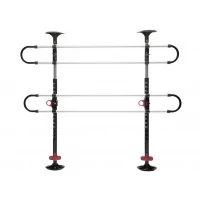Transmission
Whether your vehicle comes with a manual transmission or its automatic counterpart, it performs the same function, transferring engine power to the drive wheels. It does this in a very efficient way, delivering more torque at lower speeds and less torque at higher speeds using different gears. The latter allows for better fuel economy and higher cruising speeds without overloading your engine.

In case with a manual transmission, all gear manipulations are your responsibility. You must use your clutch pedal to disengage the clutch and the gear shifter to switch between gears based on your vehicle’s speed. On the other side, if you own a car or truck with an automatic transmission, gear shifting is made automatically depending on the driving speed. Such systems rely on hydraulic power and computer controlled sensors and solenoids to keep the vehicle running in the right gear.
Depending on the type of the transmission you have, it may provide different warning signs when it’s getting damaged or malfunctions. Let’s check them one by one.
Manual transmission
Clutch slippage
Your clutch is a crucial part of the transmission assembly, connecting the engine to the transmission input shaft. If the clutch disk wears out or your clutch pedal is not properly adjusted, you may experience clutch slippage when an increase in engine speed doesn’t cause your vehicle to accelerate.
Shifting problems
If you can’t shift into the desired gear or you feel like your transmission is jumping out of gear, this can be an indicator of worn-out synchronizer rings or gear teeth. Both issues will require transmission inspection and disassembling.
Abnormal noises
Any whining, grinding or growling noises are a sign of worn-out transmission components or a low fluid level. In many cases a growling noise is a result of poor bearings, while grinding is usually caused by bad gears.
Fluid leaks
Transmission fluid leaks are a typical sign of poor seals and gaskets. Another common place of leaks is the drain plug. So, if you detect a fluid leak, the drain plug and seals should be checked first. Depending on the type of the fluid you use, the leaks can be brown (engine oil or gear oil) or red (automatic transmission fluid).
Your vehicle doesn’t move
This is the worst scenario you may face. It means your transmission or clutch has got a critical damage and needs a rebuild or replacement.
Automatic transmission
Warning lights come on
Your powertrain control unit or transmission control module keeps an eye on transmission operation. If it detects any irregularities in its operation, the computer will turn on the warning lights. It can also activate the “limp-home” mode to prevent severe damage to the transmission.
Abnormal noises
Just like with a manual transmission, abnormal sounds coming from your automatic transmission are triggers of certain problems. Thus, grinding is a sign of worn-out planetary gears, while whining says about a failing transmission front pump.
Shifting problems or slippage
This can be caused by a variety of transmission issues, running the gamut from a faulty sensor or solenoid to a damaged or worn-out valve body.
Fluid leaks
The most common locations of fluid leaks are the front pump seal, oil pan seal, and the output shaft seal. Automatic transmission fluid leaks can be identified based on the color of the fluid. As a rule, it is red or reddish-brown.
Your vehicle doesn’t move
If your vehicle can’t move while the engine is running, your automatic transmission can keep the car from moving due to a catastrophic failure. In some cases you can be left with just one or two gears available.
How to fix a bad transmission
The first step in your to-do list should be a thorough transmission diagnosis. It’s better to leave this job to a professional as it usually involves special scan tools and a strong understanding of transmission operation.
Depending on the damage caused to the transmission, a mechanic can offer you either to rebuild or to replace the transmission assembly. The latter option is the worst-case scenario that means your transmission is out of service and not repairable. If your car is old with lots of mileage, you may consider purchasing a used transmission or another car instead of having your transmission replaced.
Once the transmission is replaced or rebuilt, it must be refilled with oil and checked for leaks and proper operation. If you have an automatic transmission, it is always a good idea to flush the cooler and replace the torque converter if the whole assembly is replaced. In case with a manual transmission, the flywheel should be resurfaced or replaced along with the clutch.





